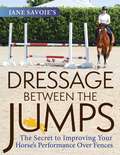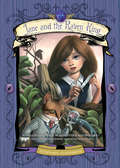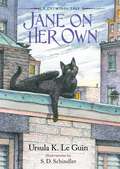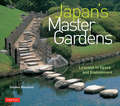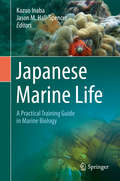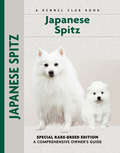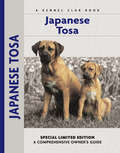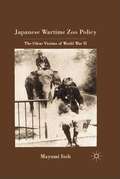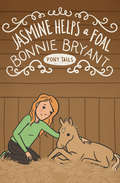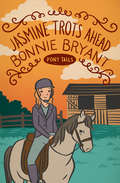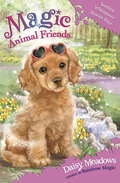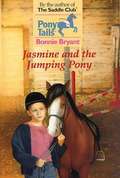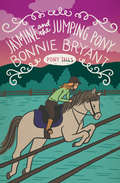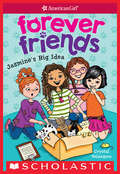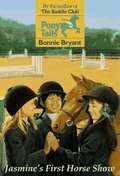- Table View
- List View
Jane Savoie's Dressage Between the Jumps
by Jane SavoieA compelling collection of focused flatwork exercises for improving jumping performance. Renowned author and mental training coach Jane Savoie breaks down the six most common problem areas she sees when horses jump: “Whoa” and “go” Rhythm Suppleness through the poll, neck, body, back, and hindquarters Contact and connection Collection Flying changes Then Savoie fills the rider’s toolbox with targeted exercises on the flat―simple solutions to the nagging problems that prevent riders and horses from doing their best over all kinds of obstacles, whether competing in hunters, jumpers, equitation, or eventing. Her excellent lessons gradually incorporate ground poles and low fences to build skills without stressing the horse’s body. Throughout, top riders share their own stories and insight, demonstrating numerous ways dressage exercises helped solve real problems over fences, including Olympian Anne Kursinski, Nations Cup rider Paul O’Shea, and eventer Nancy Bliss Byrd. With incredible clarity and her trademark enthusiasm, Savoie arms readers with knowledge, confidence, and problem-solving prowess that will result not only in clear rounds, but a happier horse, ready and willing to perform in partnership.Jane Savoie was the first to promote mental training tools and techniques as integral to competitive riding success, and her cross-training concepts for the horse-how to use dressage fundamentals for every equestrian sport-have been called “not just a read, but a must read for every hunter-jumper rider.”
Jane and the Raven King
by Stephen ChambersOutside the window, a squirrel in a tree popped out with a little black suitcase. At first, Jane was sure she must be mistaken, but as she watched, the squirrel opened the tiny suitcase and began arranging nuts and acorns inside. . . <P><P>The animals clearly knew something was wrong. Even her pet iguana scrawled a warning in the sand of his tank: He is coming. <P><P>Soon all the animals are fleeing the suburb where Jane lives. But they aren't the only ones acting strange. Jane's parents seem to be hypnotized by their cell phones and the TV. And her grandma starts controlling the weather and speaking in a funny language. But when Jane meets an old blind man who can drive a car and claims Jane is the only one who can save the world, well, that's when things really start to get weird. . .
Jane on Her Own (Catwings #4)
by Ursula K. Le GuinJane has a city adventure in this fourth book in legendary author Ursula K. Le Guin&’s bestselling Catwings chapter book series, now with a new look!Jane, the youngest of the Catwings, thinks that life on the farm is absolutely boring. Looking for adventure, she takes to the skies to explore all the world has to offer. But when she flies through the window of a friendly-seeming human, Jane finds herself captured—and forced to make TV appearances as Miss Mystery, the fabulous winged cat. How can she possibly explore the world now? Is there anywhere Jane can be truly free?
Jane on Her Own (Catwings Series #4)
by Ursula K. Le GuinJane is restless. What's the use of having wings and being able to fly if she never gets to go anywhere or see anything? "It's too dangerous," says her big sister Harriet. "If human beings saw cats with wings, they'd put us in cages." But Jane refuses to listen. There are adventures waiting beyond the farm, and she is eager to find them. And find them she does. She flies to the city-and through the window of a man who makes her a TV star! But her pampered life is too much like a cage. Brave Jane escapes, to seek new friends, old friends, and true freedom. Book 4 in the Catwings series.
Jangles: A Big Fish Story
by David ShannonBestselling storyteller David Shannon instantly hooks readers with this stunning, highly entertaining tour-de-force--his best book ever!Breathtaking oil paintings bursting with energy pullreaders along into Big Lake, the home of Jangles, thebiggest fish anyone has seen. Fishing alone at dusk,a boy feels a tug on his line and comes face-to-facewith the gigantic trout--whose enormous jaw is coveredwith so many lures and fish hooks that he jingles andjangles when he swims. Terrified by the sight, the boy isshocked when Jangles befriends him and takes him on anadventure to the bottom of the lake. A surprise endingwill leave readers laughing and shaking their heads. Hereis Shannon at his very best-in a wild and witty story thatbegs repeated reading.
Japan's Master Gardens
by Stephen MansfieldNo two Japanese gardens are ever the same. Each is inimitable, yet embodies commonalities of design and aesthetic taste. Each finds the space for innovation within a tradition that benefits from a thousand years of applied knowledge. Presenting twenty-five master gardens, Japan's Master Gardens explores the ingenuity and range of Japanese landscaping, from the self-imposed confines of courtyard designs to the open expanses of the stroll garden.Japan's Master Gardens illustrates how, through the ministrations of generations of gardeners, original landscapes have maintained their mastery and demonstrates how contemporary landscaping draws from tradition, making ancient gardens relevant to the lives of people in the twenty-first century.This beautifully illustrated book takes readers on an exploration of the outward forms, underpinning principles, complex use of metaphor and allusion, and beauty and depth that set the Japanese garden apart.
Japan's Withdrawal from International Whaling Regulation
by Nikolas Sellheim Joji MorishitaThis book examines the impact and implications of Japan's withdrawal from the International Convention for the Regulation of Whaling (ICRW), which came into effect in July 2019. In 1982 the International Whaling Commission (IWC) adopted a moratorium on commercial whaling which has been in effect ever since, despite the resistance of some countries, first and foremost Japan, Norway and Iceland, that engage in commercial whaling. As one of the key contributors to scientific research and funding, Japan's withdrawal has the potential to have wide-ranging implications and this volume examines the impact of Japan's withdrawal on the IWC itself, on the governance of whaling, and on indigenous and coastal whaling. It provides backgrounds and commentaries on this decision as well as normative and legal discussions on matters relating to sustainable use of resources, and philosophies surrounding whaling in different IWC countries. The consideration of other international environmental regimes, such as the Convention on International Trade in Endangered Species (CITES) are also examined in order to determine the international ripple effect of Japan’s decision. The book reveals that this is not just a matter of whaling but one which has significant legal, managerial and cultural implications. Drawing on deep analyses of IWC structures, the book addresses core philosophies underlying the whaling debate and in how far these may influence environmental governance in the future. This book will be of great interest to students and scholars of environmental law and governance, biodiversity conservation and sustainable development, as well as policymakers involved in international environmental and conservation agreements.
Japan's Withdrawal from International Whaling Regulation (Routledge Studies in Conservation and the Environment)
by Nikolas Sellheim Joji MorishitaThis book examines the impact and implications of Japan’s withdrawal from the International Convention for the Regulation of Whaling (ICRW), which came into effect in July 2019. In 1982 the International Whaling Commission (IWC) adopted a moratorium on commercial whaling which has been in effect ever since, despite the resistance of some countries, first and foremost Japan, Norway and Iceland, that engage in commercial whaling. As one of the key contributors to scientific research and funding, Japan’s withdrawal has the potential to have wide-ranging implications and this volume examines the impact of Japan’s withdrawal on the IWC itself, on the governance of whaling, and on indigenous and coastal whaling. It provides backgrounds and commentaries on this decision as well as normative and legal discussions on matters relating to sustainable use of resources, and philosophies surrounding whaling in different IWC countries. The consideration of other international environmental regimes, such as the Convention on International Trade in Endangered Species of Wild Fauna and Flora (CITES), is also examined in order to determine the international ripple effect of Japan’s decision. The book reveals that this is not just a matter of whaling but one which has significant legal, managerial and cultural implications. Drawing on deep analyses of IWC structures, the book addresses core philosophies underlying the whaling debate and in how far these may influence environmental governance in the future. This book will be of great interest to students and scholars of environmental law and governance, biodiversity conservation and sustainable development, as well as policymakers involved in international environmental and conservation agreements.
Japanese Chin
by Isabelle Francais Juliette CunliffeFrom the Land of the Rising Sun comes the delightful and affectionate toy dog known as the Japanese Chin, revered for centuries as a palace treasure and today counted among the world's most beloved companion dogs. This Comprehensive Owner's Guide, written by Juliette Cunliffe, provides an entertaining portrait of the Chin's origins and history, including Commodore Perry's famous door-opening visit to Japan, the breed's rise to the favor of England's Queen Alexandra, and the Chin's introduction to the United States. In the chapter on the breed's characteristics, the author reveals her insight into this "happy little character with a down-to-earth, yet bumptious, personality." Potential owners are made aware that, despite his small size, the Chin has a larger-than-life approach to the world, and that as a home companion, the Chin demands affection and little else, being a naturally clean pet, often compared to a cat in cleanliness, sophistication, and self-awareness. In the home of a loving owner, the Chin will thrive and become a superb addition to the family, even one with children and cat or two!New owners will welcome the well-prepared chapter on finding a reputable breeder and selecting a healthy, sound puppy. Chapters on puppy-proofing the home and yard, purchasing the right supplies for the puppy as well as house-training, feeding, and grooming are illustrated with photographs of handsome adults and puppies. In all, there are over 135 full-color photographs in this useful and reliable volume. The author's advice on obedience training will help the reader better mold and train into the most well-mannered dog in the neighborhood. The extensive and lavishly illustrated chapter on healthcare provides up-to-date detailed information on selecting a qualified veterinarian, vaccinations, preventing and dealing with parasites, infectious diseases, and more. Sidebars throughout the text offer helpful hints, covering topics as diverse as historical dogs, breeders, or kennels, toxic plants, first aid, crate training, carsickness, fussy eaters, and parasite control. Fully indexed.
Japanese Commons in the Coastal Seas
by Tetsuo YanagiThe author proposed the satoumi concept, analogous to the satoyama concept on land, as "coastal sea with high biodiversity and productivity in harmony with human interaction" in 1998. The concept for environmental conservation in the coastal seas has been widely accepted and was included in the Japanese national policy of "Strategy for Establishment of an Environmental Nation" in 2007. This book is a translation of the author's Japanese book (2010) in response to concerns and questions about satoumi, including: Does biodiversity increase as a result of human interaction in coastal seas? Do the economics of fishing villages need to be considered in detail? What legal support is necessary for the creation of satoumi? Is there a relation between the concepts of God and Nature in satoumi? What is the relationship between fishermen and city dwellers? Chapter 1 presents the basic concept of satoumi. In Chapter 2 the relation between biodiversity and human interaction, economic problems related to satoumi, legal support for satoumi creation, satoumi from the point of view of landscape ecology, and the relation between society and science with regard to the satoumi movement are discussed. In Chapter 3 examples of satoumi creation in Japan are presented, and in Chapter 4 the overseas dissemination of the satoumi concept is introduced, with Chapter 5 providing the conclusion. Chapter 1 presents the basic concept of satoumi. In Chapter 2 the relation between biodiversity and human interaction, economic problems related to satoumi, legal support for satoumi creation, satoumi from the point of view of landscape ecology, and the relation between society and science with regard to the satoumi movement are discussed. In Chapter 3 examples of satoumi creation in Japan are presented, and in Chapter 4 the overseas dissemination of the satoumi concept is introduced, with Chapter 5 providing the conclusion.
Japanese Garden Design
by Marc P. Keane Haruzo OhashiThe creation of a Japanese garden combines respect for nature with adherence to simple principles of aesthetics and structure. In Japanese Garden Design, landscape architect Marc Peter Keane presents the history and development of the classical metaphors that underlie all Japanese gardens.Keane describes the influences of Confucian, Shinto and Buddhist principles that have linked poetry and philosophy to the tangible metaphor of the garden. Detailed explanations of basic design concepts identify and interpret the symbolism of various garden forms and demonstrate these principles in use today.
Japanese Marine Life: A Practical Training Guide in Marine Biology
by Kazuo Inaba Jason M. Hall-SpencerThis book gives an overview of the diverse marine fauna and flora of Japan and includes practical guides for investigating the biology and ecology of marine organisms. Introducing marine training courses offered at a range of Japanese universities, this is the first English textbook intended for marine biology instructors and students in Japan. It provides essential information on experimental procedures for the major areas of marine biology, including cell and developmental biology, physiology, ecology and environmental sciences, and as such is a valuable resource for those in Asian countries that share a similar flora and fauna. It also appeals to visitors interested in attending Japanese marine courses from countries around the world.
Japanese Spitz (Comprehensive Owner's Guide)
by Michael P. RuleThis Special Rare-Breed Edition, written by British Japanese Spitz breeder Michael P. Rule, proves a vital resource for dog lovers interested in this spectacular Nordic breed.<P><P> Colorful and comprehensive in its scope, this book discusses breed history, accompanied by many important historical photographs, plus breed characteristics and standard as well as health care, grooming, obedience and house-training, puppy selection and everyday care.
Japanese Tosa (Comprehensive Owner's Guide)
by Serena Burnett Steve OstuniWeighing in at up to 200 pounds, the Sumo wrestler of the dog world-the Japanese Tosa-was once the prize fighter in the nation's dog pits. <P><P>Today, this canine wonder, possessing proverbial loyalty and courage, is an esteemed guard dog and protector of home and property, a faithful family companion, and an impressive show dog. Written by Tosa breeder Steve Ostuni of the famous DogStar Kennels, this Comprehensive Owner's Guide begins with a chapter retelling the Tosa's colorful origins in Japan, including the breed's turbulent history as a fighting dog, its rise to the status of a cultural icon in Japan, and the worldwide attention the breed garnered in Western nations, especially the United States and Europe. (Sadly, this noble and worthy breed was banned in Britain, thus the breed has no history in that country.) The author's chapter on the breed's characteristics well describes the physical traits and unique temperament of this naturally dominant canine that requires an experienced owner able to contend with the dog's tremendous strength and determination. The same traits that made the Tosa an indomitable fighting dog serve the breed well as a home guardian. The author strongly urges new owners to seriously pursue the socialization and training of young dogs to thereby mold these awesome canines to become the trustworthy, unshakeable companions they are meant to be.New owners will welcome the well-prepared chapter on finding a reputable breeder and selecting a healthy, sound puppy. Chapters on puppy-proofing the home and yard, purchasing the right supplies for the puppy as well as house-training, feeding, and grooming are illustrated with photographs of handsome adults and puppies. In all, there are over 135 full-color photographs in this useful and reliable volume. The author's advice on obedience training will help the reader better train his Tosa into an obedient and biddable companion. The extensive and lavishly illustrated chapter on healthcare provides up-to-date detailed information on selecting a qualified veterinarian, vaccinations, preventing and dealing with parasites, infectious diseases, and more. Sidebars throughout the text offer helpful hints, covering topics as diverse as historical dogs, breeders, or kennels, toxic plants, first aid, crate training, carsickness, fussy eaters, and parasite control. Fully indexed.
Japanese Wartime Zoo Policy
by Mayumi ItohThis book examines Japanese wartime zoo policy during World War II, analyzing the reasons why the Home Ministry destroyed more than 300 showpiece animals throughout Japan well before U. S. air strikes were anticipated, with international comparisons of the effects of the war on zoos in Europe, the United States, and the Middle East.
Japanese Woodblock Flower Prints
by Tanigami KônanExceptionally drawn in a realistic fashion and awash in spectacularly rich colors, this one-of-a-kind art book -- masterfully reprinted from a rare and costly edition -- combines the perennial appeal of flowers with the art of Japanese woodblock prints.Nothing expresses the richness and vigor of life like blooming flowers. A stunning showcase of 120 full-color plates, this specially chosen collection features beautiful Eastern and Western botanicals that will delight flower lovers, artists, designers, and devotees of fine art. Admire such familiar and unusual blossoms as the poppy, rose, anemone, cyclamen, delphinium, water lily, lupine, passion flower, allamanda, phlox, dahlia, petunia, tulip, freesia, pansy, begonia, and many more beautiful blooms!Tanigami Kônan (1879-1928) was a genius at the art of woodblock creation and color gradation, and he is still celebrated as one of the finest artists of this highly specialized technique. Captions and a complete index are included in this distinct keepsake edition.
Jasmine Helps a Foal (Pony Tails #10)
by Bonnie BryantJasmine loves her new little sister. But having a baby in the house isn't easy! Sometimes Jasmine feels like they forgot all about their first kid. Then a baby foal is born at Pine Hollow Stables, and Max is going to let Jasmine help take care of it. Finally, maybe someone will appreciate having Jasmine around.
Jasmine Helps a Foal (Pony Tails #10)
by Bonnie BryantWith a new baby around, Jasmine feels invisible—until a foal needs her help Jasmine is thrilled about becoming a big sister. She&’s even been practicing with a doll her parents gave her. But when baby Sophie comes, her parents seem to forget all about Jasmine. Pine Hollow Stables has also welcomed a new baby—an adorable foal with sweet eyes and soft hair, who needs a ton of love and attention. And Jasmine is up to the challenge.
Jasmine Trots Ahead (Pony Tails #7)
by Bonnie BryantJasmine gets to train with the best rider at Pine Hollow Stables—but there&’s one member of the club who is not happy about itThe Pony Tails&’ riding teacher, Max, has assigned each of the girls a &“big sister&” from the Pony Club to help them improve their skills. When Jasmine is assigned to Carole Hansen, the best rider at Pine Hollow Stables, the other girls are jealous—especially Erin Mosley. Erin doesn&’t think it&’s fair, and says she&’s going to make Jasmine sorry. Will her nasty schemes ruin Jasmine&’s chances of winning a blue ribbon? Not if the Pony Tails can help it!
Jasmine Whizzpaws to the Rescue: Book 29 (Magic Animal Friends #29)
by Daisy MeadowsAn enchanting series full of adorable animals, magic and friendship - from the creator of RAINBOW MAGIC, the UK's bestselling series for girls aged 5-7.Welcome to a magical world where animals talk and play - just like you and me!Best friends Jess and Lily love all animals. But when they follow a mysterious golden cat into Friendship Forest - a place where animals live in tiny cottages and sip dandelion tea at the Toadstool Cafe - their animal friends suddenly become much more magical!
Jasmine and the Jumping Pony (Pony Tails #16)
by Bonnie BryantJasmine James is thrilled at the thought of taking her first real jumping class at Pine Hollow Stables. She and her pony, Outlaw, have done some jumping before, but now they are going to learn the correct way to get over those fences.
Jasmine and the Jumping Pony (Pony Tails #16)
by Bonnie BryantJasmine is great at riding ponies, but she&’s about to learn that jumping can be especially challenging Jasmine and her friends the Pony Tails are crazy about animals—especially ponies. This year, Jasmine and her pony Outlaw are taking their first jumping lesson at Pine Hollow Stables, and she couldn&’t be more excited. All she can think about is jumping! But during the lesson, Jasmine falls off Outlaw going over the very first jump. She is disappointed, embarrassed, and scared. Will Jasmine and Outlaw ever learn to jump like pros?
Jasmine's Big Idea (American Girl: Forever Friends #1)
by Crystal VelasquezJasmine Arroyo loves volunteering with her veterinarian mom at the Kew Gardens Animal Shelter. When Jasmine learns that the shelter will have to turn away new animals unless it can raise funds to expand, she is determined to help in any way she can. Fortunately, Jasmine's best friends Sofia and Keiko want to help, too! The shelter is throwing a fundraiser and the girls decide to create a kids craft corner. They can draw pictures of all the shelter animals to help them find their forever homes. But when a new girl named Madison starts volunteering at the shelter, she starts to take over the group! Can Jasmine help the shelter without losing her friends?
Jasmine's Christmas Ride (Pony Tails #4)
by Bonnie BryantThe Pony Tails get in the holiday spirit for two Christmas horse shows at Pine Hollow StablesAs Christmas draws near, the Pony Tails get excited about two Pony Club holiday events at Pine Hollow Stables: the annual Starlight Ride on Christmas Eve and a special horse show to raise money for the local animal shelter.Both Corey and Jasmine have been practicing hard in hopes of being chosen to perform in a special presentation at the show. But when only Corey is selected to ride in the show, the girls&’ holiday cheer disappears. Jasmine feels left out, and Corey is embarrassed that she was chosen. Poor May is stuck in the middle. Will the three best friends be able to work things out before the night of the Starlight Ride? It may take a Christmas miracle!
Jasmine's First Horse Show (Pony Tails #13)
by Bonnie BryantJasmine is thrilled to be getting ready for her first horse show. Then bad things start happening. Her pony, Outlaw, can't be ridden. Her baby sister, Sophie, gets sick and her parents have to stay home to take care of her. Jasmine's first horse show is ruined before it's even begun. Then Jasmine learns that sometimes you can't get everything you want, but life has a way of working out anyhow.
